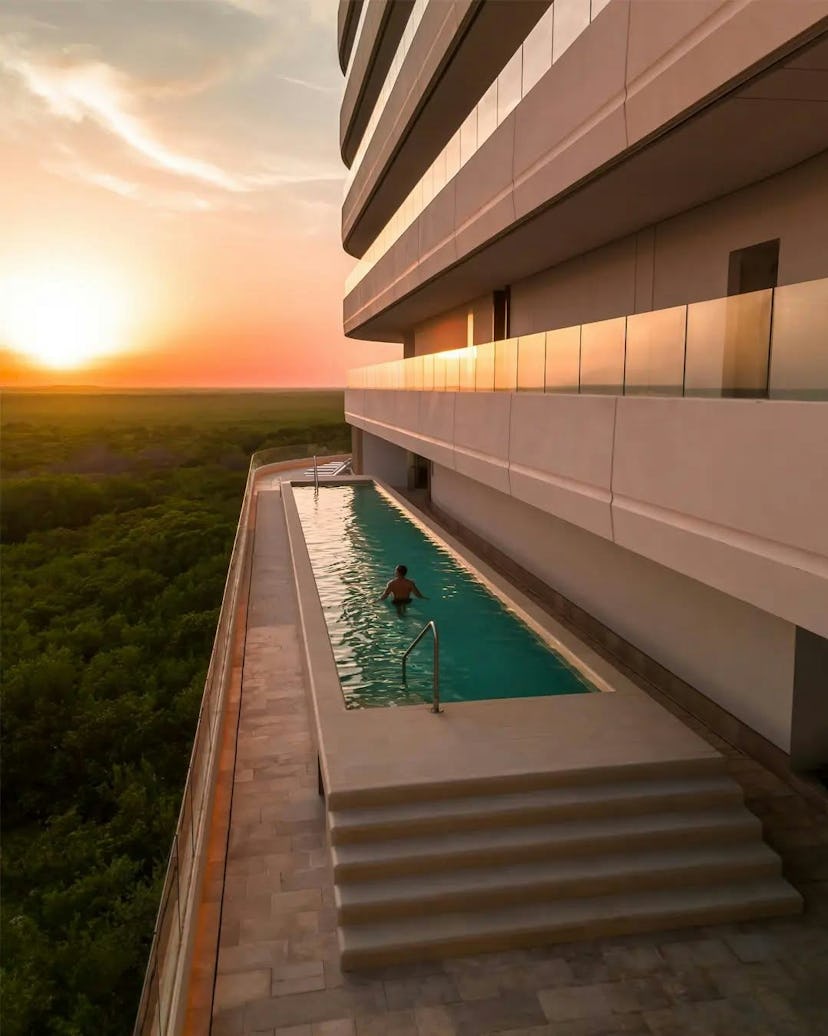I’m in a private spa chamber at Maxx Royal Bodrum Resort on the Turkish Riviera, with a Balinese therapist tucking me into a Nuvola dry floatation therapy bed. With the click of a button, the bed lowers, and I float as if in water, but I'm completely dry. Allegedly, this treatment improves my sleep quality, enhance muscle recovery, drain my lymphatic system, and reduce stress. I booked a stay at the resort to enjoy a few hedonistic days of summer, yet I find myself in the midst of a full-body health reset. Instead of deciding what outfit to wear dancing with friends, I’m torn between wellness treatments: an ozone sauna designed to flush toxins and boost circulation, or an osteopathy session to release my deep muscular tension after a transatlantic flight?
A few days later, I travel to Crete to stay at Phāea Cretan Malia. I happen to arrive during the hotel’s harvest moon wellness weekend, designed to celebrate the beginning of fall. My planned aperitivos and late-night jaunts are suddenly an afterthought, as it’s all sunrise meditations, breathwork ceremonies, herbal tea blessings, and restorative yoga with aromatherapy.
Though my holiday isn’t what I expected, I absolutely love it.
These days, there is a surprise wellness focus at many hotels. Between 2022 and 2023, the wellness tourism economy grew by 30%, per a report from the Global Wellness Institute. More than 90% of luxury travelers seek wellness programs on vacation, according to a recent report by the International Luxury Travel Market, while over 70% of travelers say they’re more likely to book a hotel if it offers specialized options. That isn’t simply fully-equipped gyms, but everything from salt rooms and ice baths to hyperbaric oxygen pods and biohacking recovery lounges with vitamin drips and oxygen masks.
While the ubiquity is new, the premise is not. In the 1940s, Rancho La Puerta in Tecate, Mexico, became one of the world’s first true wellness resorts, offering a holistic philosophy of exercise, organic food, and natural therapies. Over the following decades, a few wellness stalwarts emerged. Since 1975, San Montano Resort & Spa in Ischia, a volcanic island off Italy’s Campania coast, has welcomed travelers to its mountain top perch, where 11 outdoor thermal pools are the precursor to mineral-rich volcanic clay therapies. In 1988 came the Aman Resorts, where minimalist spas have personalized healing journeys that might include sound therapy, Ayurvedic treatments, or traditional Chinese medicine consultations. In 2008, the Spanish resort-clinic SHA came on the scene, offering a blend of Eastern and Western medicine, as well as advanced diagnostics conducted by doctors and biohacking technologies.
Perhaps most famous of all is Lanserhof, which is renowned for its high-tech diagnostics and fasting clinics. Since first opening in Lans, Austria, in 1984, it has expanded to Tegernsee and Sylt. Each stay begins with guests undergoing comprehensive medical testing—blood and microbiome analysis, metabolic panels, and advanced imaging—to inform their individual wellness program, which might include regenerative treatments like blood purification.
AI Supported 3D Skin Cancer Prevention at Lanserhof Sylt
According to Lanserhof’s Chief Commercial Officer, Eva-Maria Hasenauer, the increased demand for wellness hotels is due to rising stress, career burnout, and post-pandemic health awareness, particularly among next-generation travelers. “Younger generations with disposable income increasingly value experiences over possessions and see wellness as part of their lifestyle and identity,” says Hasenauer. “Older travelers seek preventive health and longevity solutions. It's more than just spa menus. It’s about fitness, nutrition, mental health, sustainability, and even advanced medical care.” This demand is clear in Lanserhof’s expansions: they recently opened urban clinics in Hamburg and London. A new outpost is slated to open in Marbella, Spain, in 2026.
With wellness tourism projected to reach $1.4 trillion globally by 2027, according to the Global Wellness Institute, many regular hotel brands are investing in health options and promoting themselves as wellness properties. Six Senses, which has locations in Rome and London—and is soon opening in Milan, Dubai, and Lisbon—offers a sleep program designed by the clinical psychologist Dr. Michael Breus, which includes complementary trackers to measure sleep metrics. They launched a female wellness program earlier this year in partnership with Dr. Mindy Pelz for women going through perimenopause and menopause.
Proper Hospitality, with a collection of design-forward hotels in cities like Los Angeles and Austin, has announced the debut of Proper Club at its Santa Monica location: a wellness membership for members and frequent guests. Recovery-focused amenities include the Ammortal Chamber, a high-tech recovery pod for cellular regeneration and stress relief. Even safaris are getting in on the trend. Wilderness, a luxury safari company with camps and lodges across Africa, is opening The Sanctuary at Wilderness Bisate Lodge in Rwanda this December. A first-of-its-kind center in the country, the hotel lets travelers trek with gorillas by morning and slip into a hyperbaric oxygen chamber by night.
For Marta Roszkowski—a 39-year-old human resources executive based in New York who regularly invests in therapy, exercise classes, and massages—choosing hotels that prioritize wellness is a no-brainer. “When I travel, I want to feel just as good, if not better, than I do at home,” says Roszkowski. “I get just as excited about booking a Turkish hammam as I do about enjoying a memorable Michelin-star meal or seeing a gallery exhibition. Wellness is part of how I experience a culture.”
